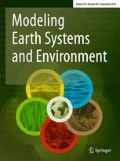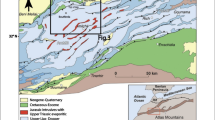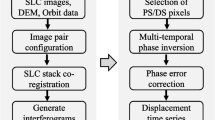Abstract
Nowadays, digital elevation models (DEMs), with their simple data structure and widespread availability, became the main source for representing Earth’s surface and have been an integral part of any geospatial analysis, in particular, geomorphometric research. Spaceborne photogrammetry remains an important technique for obtaining high-resolution elevation data, especially over large or/and inaccessible areas. However, DEMs acquired directly through remote sensing based instruments; such as photogrammetric DEMs, are prone to a severe amount of uncertainty. The aim of this research is to provide a relatively comprehensive understanding of high-resolution Spaceborne photogrammetric DEM generation and enhancement for geomorphometric studies over regions with relatively low relief such as Sahel-Doukkala. To perform such analysis, a total of five interpolation algorithms available in most GIS software packages and commonly used in geomorphological studies; namely ANUDEM, IDW, OK, MQ and TPS, were selected and compared with respect to different spatial resolution, viz. 5 m, 10 m, 20 m and 30 m. Moreover, the impact of DEM filtering algorithms on introduced errors were examined in order to find the optimal strategy for removing errors and enhancing the modeled topographic surface. Results have been revealed that ANUDEM algorithm performs well when compared to other algorithms, in terms of accuracy as well as the natural look of the modeled surface. In addition, investigations demonstrate that spatial resolution of 10 m shows a satisfactory compromise between reducing errors and keeping topographic details. Furthermore, a combination of three digital filters which are Gaussian filter, median filter, and slope based filter, were able to reduce different sources of errors and to improve the elevation accuracy of DEM by 5% as so as the derived geomorphometric parameters.











Similar content being viewed by others
References
Aguilar FJ, Agüera F, Aguilar M, Carvajal F (2005) Effects of terrain morphology, sampling density, and interpolation methods on grid DEM accuracy. Photogramm Eng Remote Sens 71:805–816. https://doi.org/10.14358/PERS.71.7.805
Akovetsky VG (1994) Efficiency improvement of stereoscopic measurements. Geod i Cartogr 1:29–33
Albani M, Klinkenberg B (2003) A spatial filter for the removal of striping artifacts in digital elevation models. Photogramm Eng Remote Sens 69:755–765
Anderson ES, Thompson JA, Crouse DA, Austin RE (2005) Horizontal resolution and data density effects on remotely sensed LIDAR-based DEM. Geoderma 132:406–415. https://doi.org/10.1016/j.geoderma.2005.06.004
Arun PV (2013) A comparative analysis of different DEM interpolation methods. Egypt J Remote Sens Sp Sci 16:133–139. https://doi.org/10.1016/j.ejrs.2013.09.001
Caruso C, Quarta F (1998) Interpolation methods comparison. Comput Math with Appl 35:109–126. https://doi.org/10.1016/S0898-1221(98)00101-1
Carvalho Júnior OA, Guimarães RF, Montgomery DR et al (2013) Karst depression detection using ASTER, ALOS/PRISM and SRTM-derived digital elevation models in the Bambuí group, Brazil. Remote Sens 6:330–351. https://doi.org/10.3390/rs6010330
Chaplot V, Darboux F, Bourennane H et al (2006) Accuracy of interpolation techniques for the derivation of digital elevation models in relation to landform types and data density. Geomorphology 77:126–141. https://doi.org/10.1016/j.geomorph.2005.12.010
Conrad O, Bechtel B, Bock M et al (2015) System for automated geoscientific analyses (SAGA) v. 2.1.4. Geosci Model Dev 8:1991–2007. https://doi.org/10.5194/gmd-8-1991-2015
Cressie NAC (1993) Statistics for spatial data. Wiley, Hoboken
Davis BM (1987) Uses and abuses of cross-validation in geostatistics. Math Geol 19:241–248. https://doi.org/10.1007/BF00897749
Desmet PJJ (1997) Effects of interpolation errors on the analysis of DEMs. Earth Surf Process Landforms 22:563–580
Doucette P, Beard K (2000) Exploring the capability of some GIS surface interpolators for DEM gap fill. Photogramm Eng Remote Sens 66:881–888
Elmahdy SI, Mohamed MM (2013) Remote sensing and GIS applications of surface and near-surface hydromorphological features in Darfur region, Sudan. Int J Remote Sens 34:4715–4735
Erdogan S (2009) A comparision of interpolation methods for producing digital elevation models at the field scale. Earth Surf Process Landf 34:366–376. https://doi.org/10.1002/esp.1731
Evans JS, Hudak AT (2007) A multiscale curvature algorithm for classifying discrete return LiDAR in forested environments. IEEE Trans Geosci Remote Sens 45:1029–1038
Felicísimo AM (1994) Parametric statistical method for error detection in digital elevation models. ISPRS J Photogramm Remote Sens 49:29–33. https://doi.org/10.1016/0924-2716(94)90044-2
Fisher PF, Tate NJ (2006) Causes and consequences of error in digital elevation models. Prog Phys Geogr 30:467–489
Florinsky IV (1998) Accuracy of local topographic variables derieved from digital elevation models. Int J Geogr Inf Sci 12:47–61. https://doi.org/10.1080/136588198242003
Florinsky IV (2012) Digital terrain analysis in soil science and geology, 1st edn. Academic, New York
Forkuor G, Maathuis B (2012) Comparison of SRTM and ASTER derived digital elevation models over two regions in Ghana—implications for hydrological and environmental modeling. In: Piacentini T, Miccadei E (eds) Studies on environmental and applied geomorphology. Intech, Zagreb, pp 219–240
Gong J, Zhllin L, Zhu Q et al (2000) Effects of various factors on the accuracy of DEMs: an intensive experimental investigation. Photogramm Eng Remote Sens 66:1113–1117
Guo Q, Li W, Yu H, Alvarez O (2010) Effects of topographic variability and Lidar sampling density on several DEM interpolation methods. Photogramm Eng Remote Sens 76:701–712. https://doi.org/10.14358/PERS.76.6.701
Habib A, Akdim N, El Ghandour F et al (2017) Extraction and accuracy assessment of high resolution DEM and derived orthoimages from ALOS-PRISM data over Sahel-Doukkala (Morocco). Earth Sci Inform 10:197–217. https://doi.org/10.1007/s12145-017-0287-5
Harrison JM, Lo C-P (1996) PC-based two-dimensional discrete fourier transform programs for terrain analysis. Comput Geosci 22:419–424. https://doi.org/10.1016/0098-3004(95)00104-2
Hodgson ME, Bresnahan P (2004) Accuracy of airborne lidar-derived elevation: empirical assessment and error budget. Photogramm Eng Remote Sensing 70:331–339
Huggett R, Cheesman J (2002) Topography and the environment. Longman Group, Harlow
Jarvis A, Rubiano J, Nelson A et al (2004) Practical use of SRTM data in the tropics—comparisons with digital elevation models generated from cartographic data. Cali, Colombia CIAT Working Document no. 198.
Jordan G (2007) Adaptive smoothing of valleys in DEMs using TIN interpolation from ridgeline elevations: an application to morphotectonic aspect analysis. Comput Geosci 33:573–585. https://doi.org/10.1016/j.cageo.2006.08.010
Kamp U, Bolch T, Olsenholler J (2003) DEM generation from ASTER satellite data for geomorphometric analysis of Cerro Sillajhuay, Chile/Bolivia. In: ASPRS 2003 annual conference. Anchorage, Alaska (USA), p 9
Karkee M, Steward BL, Aziz SA (2008) Improving quality of public domain digital elevation models through data fusion. Biosyst Eng 101:293–305. https://doi.org/10.1016/j.biosystemseng.2008.09.010
Kienzle S (2004) The effect of DEM raster resolution on first order, second order and compound terrain derivatives. Trans GIS 8:83–111. https://doi.org/10.1111/j.1467-9671.2004.00169.x
Kraus T, Schneider M, Reinartz P (2009) Orthorectification and DSM generation with ALOS-Prism data in urban areas. In: 2009 IEEE international geoscience and remote sensing symposium. IEEE, Cape Town, South Africa, pp V-33–V-36
Kravchenko AN (2003) Influence of spatial structure on accuracy of interpolation methods. Soil Sci Soc Am J 67:1564–1571. https://doi.org/10.2136/sssaj2003.1564
Li J, Chen CS (2002) A simple efficient algorithm for interpolation between different grids in both 2D and 3D. Math Comput Simul 58:125–132. https://doi.org/10.1016/S0378-4754(01)00348-2
Li Z, Zhu C, Gold C (2004) Digital terrain modeling. CRC, Boca Raton
Lloyd CD, Atkinson PM (2010) Deriving DSMs from LiDAR data with kriging. Int J Remote Sens 23:2519–2524. https://doi.org/10.1080/01431160110097998
Lopez C (1997) Locating some types of random errors in digital terrain models. Int J Geogr Inf Sci 11:677–698. https://doi.org/10.1080/136588197242149
MacEachren AM, Davidson JV (1987) Sampling and isometric mapping of continuous geographic surfaces. Cartogr Geogr Inf Sci 14:299–320. https://doi.org/10.1559/152304087783875723
Mardikis MG, Kalivas DP, Kollias VJ (2005) Comparison of interpolation methods for the prediction of reference evapotranspiration—an application in Greece. Water Resour Manag 19:251–278. https://doi.org/10.1007/s11269-005-3179-2
Meyer TH (2004) The discontinuous nature of kriging interpolation for digital terrain modeling. Cartogr Geogr Inf Sci 31:209–216. https://doi.org/10.1559/1523040042742385
Milan DJ, Heritage GL, Large ARG, Fuller IC (2010) Filtering spatial error from DEMs: implications for morphological change estimation. Geomorphology 125:160–171. https://doi.org/10.1016/j.geomorph.2010.09.012
Milledge DG, Lane SN, Warburton J (2009a) The potential of digital filtering of generic topographic data for geomorphological research. Earth Surf Process Landf 34:63–74. https://doi.org/10.1002/esp.1691
Milledge DG, Lane SN, Warburton J (2009b) Optimization of stereo-matching algorithms using existing DEM data. Photogramm Eng Remote Sens 75:323–333
Muller R, Schneider M, Radhadevi PV et al (2009) Stereo evaluation of ALOS PRISM and IKONOS in Yemen. In: 2009 IEEE international geoscience and remote sensing symposium. IEEE, Cape Town, South Africa, pp II-1–II-2
Oksanen J (2003) Tracing the gross errors of DEM-visualization techniques for preliminary quality analysis. In: Proceedings of the 21st international cartographic conference, pp 2410–2416
Prasannakumar V, Shiny R, Geetha N, Vijith H (2011) Applicability of SRTM data for landform characterisation and geomorphometry: a comparison with contour-derived parameters. Int J Digit Earth 4:387–401
Quackenbush LJ (2004) A review of techniques for extracting linear features from imagery. Photogramm Eng Remote Sens 70:1383–1392. https://doi.org/10.14358/PERS.70.12.1383
Quattrochi A, Goodchild MF (1997) Scale in remote sensing and GIS. CRC, Boca Raton
Quincey DJ, Bishop MP, Kääb A et al (2014) Digital terrain modeling and glacier topographic characterization. In: Kargel JS, Leonard GJ, Bishop MP et al (eds) Global land ice measurements from space. Springer, Berlin, pp 113–144
Reuter HI, Hengl T, Gessler P, Soille P (2009) Chap. 4 preparation of DEMs for geomorphometric analysis. In: Geomorphometry: concepts, software, applications. Elsevier, Oxford, pp 87–120
Riley SJ, DeGloria SD, Elliot R (1999) A terrain ruggedness index that quantifies topographic heterogeneity. Intermt J Sci 5:23–27
Ruiz L, Bodin X (2015) Analysis and improvement of surface representativeness of high resolution Pléiades DEMs: examples from glaciers and rock glaciers in two areas of the Andes. In: Jasiewicz J, Zwoliński Z, Mitasova H, Hengl T (eds) Geomorphometry for Geosciences. Bogucki wydawnictwo naukowe. Adam Mickiewicz University in Pozna’n, Institute of Geoecology and Geoinformation, Poznań, pp 223–226
Setianto A, Triandini T (2013) Comparison of kriging and inverse distance weighted (IDW) interpolation methods in lineament extraction and analysis. J Southeast Asian Appl Geol 5:21–29
Shaw G, Wheeler D (1985) Statistical techniques in geographical analysis. Wiley, Chichester
Šiljeg A, Lozić S, Radoš D (2015) The effect of interpolation methods on the quality of a digital terrain model for geomorphometric analyses. Teh Vjesn Tech Gaz 22:1149–1156. https://doi.org/10.17559/TV-20131010223216
Sithole G, Vosselman G (2004) Experimental comparison of filter algorithms for bare-Earth extraction from airborne laser scanning point clouds. ISPRS J Photogramm Remote Sens 59:85–101. https://doi.org/10.1016/j.isprsjprs.2004.05.004
Smith S, Holland D, Longley P (2004) The importance of understanding error in lidar digital elevation models. In: Altan O (ed) The international archives of the photogrammetry, remote sensing and spatial information sciences. International Society for Photogrammetry and Remote Sensing, Istanbul, pp 996–1001
Smith SL, Holland DA, Longley PA (2005) Quantifying interpolation errors in urban airborne laser scanning models. Geogr Anal 37:200–224. https://doi.org/10.1111/j.1538-4632.2005.00636.x
Sulebak JR (2000) Applications of digital elevation models. DYNAMAP “white paper”. SINTEF, Oslo
Thompson JA, Bell JC, Butler CA (2001) Digital elevation model resolution: effects on terrain attribute calculation and quantitative soil-landscape modeling. Geoderma 100:67–89
Tobler AWR (1970) A computer movie simulation urban growth in detroit region. Econ Geogr 46:234–240. https://doi.org/10.1126/science.11.277.620
Toutin T (2002) Impact of terrain slope and aspect on radargrammetric DEM accuracy. ISPRS J Photogramm Remote Sens 57:228–240. https://doi.org/10.1016/S0924-2716(02)00123-5
Tunalioglu N (2012) Quality test of interpolation methods on steepness regions for the use in surface modelling. Teh Vjesn Gaz 19:501–507
Vosselman G (2000) Slope based filtering of laser altimetry data. In: Schenk T, Vosselman G (eds) The international archives of photogrammetry and remote sensing. International Society for Photogrammetry and Remote Sensing, Amsterdam, pp 935–942
Wahba G (1990) Spline models for observational data. Society for Industrial and Applied Mathematics, Philadelphia
Walker JP, Willgoose GR (2006) A comparative study of Australian cartometric and photogrammetric digital elevation model accuracy. Photogramm Eng Remote Sens 72:771–779
Wechsler SP, Kroll CN (2006) Quantifying DEM uncertainty and its effect on topographic parameters. Photogramm Eng Remote Sens 72:1081–1090
Wichmann V, Conrrad V, Jochem O (2013) LiDAR point cloud processing with SAGA GIS. Hamburger Beiträge zur Physischen Geographie und Landschaftsökologie 20:81–90
Wilson JP, Gallant JC (2000) Digital Terrain Analysis. In: Wilson JP, Gallant JC (eds) Terrain analysis: principles and applications. Wiley, New York, pp 1–27
Wood JD, Fisher PF (1993) Assessing interpolation accuracy in elevation models. IEEE Comput Graph Appl 13:48–56. https://doi.org/10.1109/38.204967
Yamazaki D, Baugh CA, Bates PD et al (2012) Adjustment of a spaceborne DEM for use in floodplain hydrodynamic modeling. J Hydrol 436–437:81–91. https://doi.org/10.1016/j.jhydrol.2012.02.045
Yang GJ, Huang TS (1981) The effect of median filtering on edge location estimation. Comput Graph Image Process 15:224–245. https://doi.org/10.1016/0146-664X(81)90057-5
Yu Q, Tian J, Liu J (2004) A NOVEL contour-based 3D terrain matching algorithm using wavelet transform. Pattern Recognit Lett 25:87–99. https://doi.org/10.1016/j.patrec.2003.09.004
Zani H, Assine ML, McGlue MM (2012) Remote sensing analysis of depositional landforms in alluvial settings: method development and application to the Taquari megafan, Pantanal (Brazil). Geomorphology 161–162:82–92. https://doi.org/10.1016/j.geomorph.2012.04.003
Zevenbergen LW, Thorne CR (1987) Quantitative analysis of land surface topography. Earth Surf Process Landf 12:47–56
Author information
Authors and Affiliations
Corresponding author
Rights and permissions
About this article
Cite this article
Habib, A., Khoshelham, K., Akdim, N. et al. Impact of spatial resolution, interpolation and filtering algorithms on DEM accuracy for geomorphometric research: a case study from Sahel-Doukkala, Morocco. Model. Earth Syst. Environ. 4, 1537–1554 (2018). https://doi.org/10.1007/s40808-018-0512-3
Received:
Accepted:
Published:
Issue Date:
DOI: https://doi.org/10.1007/s40808-018-0512-3




